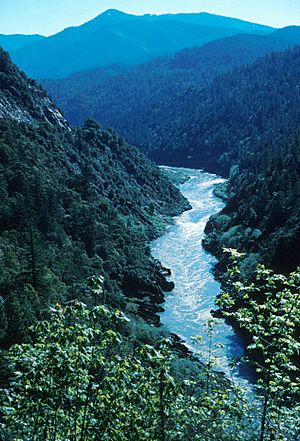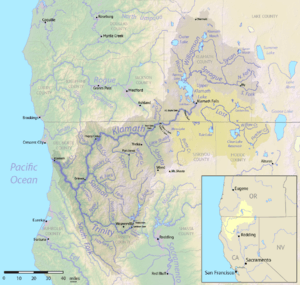Klamath River facts for kids
Quick facts for kids Klamath River |
|
|---|---|

The Klamath River in California
|
|

Map of the Klamath River watershed
|
|
| Native name | Ishkêesh |
| Other name(s) | Link River, Everglades of the West |
| Country | United States |
| State | Oregon, California |
| City | Klamath Falls |
| Physical characteristics | |
| Main source | Upper Klamath Lake Klamath Falls, Oregon 4,090 ft (1,250 m) 42°11′29″N 121°46′58″W / 42.19139°N 121.78278°W |
| River mouth | Pacific Ocean Requa, California 0 ft (0 m) 41°32′49″N 124°5′0″W / 41.54694°N 124.08333°W |
| Length | 257 mi (414 km) |
| Basin features | |
| Basin size | 15,689 sq mi (40,630 km2) |
| Type: | Wild, Scenic, Recreational |
The Klamath River is a long river in the western United States. It flows about 257 miles (414 km) through Oregon and northern California. Finally, it empties into the Pacific Ocean. It's the second-largest river in California, right after the Sacramento River.
Unlike most rivers, the Klamath starts in a high desert area. Then, it flows towards the mountains, cutting through the rugged Cascade Range and Klamath Mountains. Before reaching the sea, the river passes through different landscapes. The upper part of the river basin used to have huge freshwater marshes. These marshes were home to lots of wildlife, including millions of migratory birds. Today, this area is mostly used for farming and ranching. Much of the lower part of the river basin is still wild. It's even protected as wilderness. National Geographic magazine once called the Klamath "a river upside down." This is because it flows from the desert towards the mountains, which is unusual.
Contents
Amazing Fish of the Klamath River
The Klamath River is super important for fish that migrate. It's the most important river south of the Columbia River for anadromous fish. Anadromous fish are those that live in the ocean but swim up rivers to lay their eggs. The Klamath is home to salmon, steelhead, and rainbow trout. These fish are special because they can live in water that is warmer and more acidic than in other rivers in the Pacific Northwest.
For thousands of years, these fish were a main food source for Native Americans. They have lived in the Klamath River basin for at least 7,000 years.
A Look at Klamath River History
The first Europeans to explore the Klamath River basin were fur trappers. They worked for the Hudson's Bay Company in the 1820s. These trappers created the Siskiyou Trail. This trail followed the Klamath and Trinity rivers into the Sacramento Valley.
Later, during the California Gold Rush, many miners came to the Klamath River. They dug for gold in the river and its smaller streams. This mining caused a lot of harm to the environment. Also, new diseases brought by settlers greatly reduced the population of Native American tribes.
In the past, Steamboats traveled on the big lakes in the upper part of the river basin. This helped towns like Klamath Falls, Oregon grow. But by the late 1800s, railroads took over, and steamboats were used less.
Farms, Dams, and Water Use
In the 1800s and 1900s, the upper Klamath basin became a very productive farming area. Many dams were built on the river. These dams helped provide water for irrigation (watering crops) and create hydroelectricity (power from water).
In the 1960s, there were big plans to move Klamath River water to other parts of California. One idea, called the Klamath Diversion, would have completely changed the river's flow. It aimed to send all the Klamath River's water to farms and cities in central and southern California. Luckily, these large plans were never successful.
The Klamath River Today
Today, the Klamath River is a popular place for fun activities. People enjoy whitewater rafting and other water sports. It also provides important water for farming. Many parts of the Klamath River are still free-flowing, meaning they don't have dams.
However, the dams and water diversions in the upper river have caused problems. Sometimes, the water quality in the lower half of the river is not good. Environmental groups and Native American tribes are working together. They want to make big changes to how water is used in the Klamath Basin. They hope to remove some dams to help fish habitat grow.
These groups created the Klamath Basin Restoration Agreement. This is a plan for managing the river's water. Local communities, governments, tribal groups, environmentalists, and fishermen have all signed this agreement. The U.S. Department of the Interior supports the plan. However, the United States Congress still needs to approve it.
Images for kids
-
The Klamath River approaching its mouth on the Pacific, near Klamath, California
-
Marshlands in the Upper Klamath Basin today are remnants of the vast Lake Modoc. Mount Thielsen in the background.
See also
 In Spanish: Río Klamath para niños
In Spanish: Río Klamath para niños









